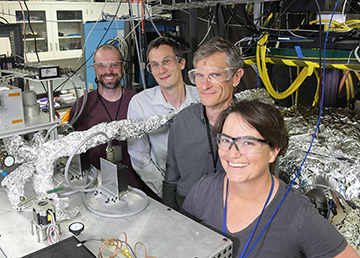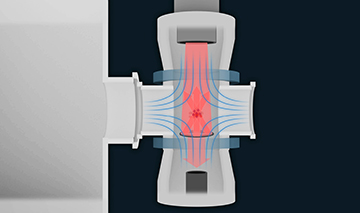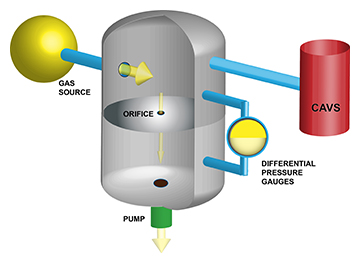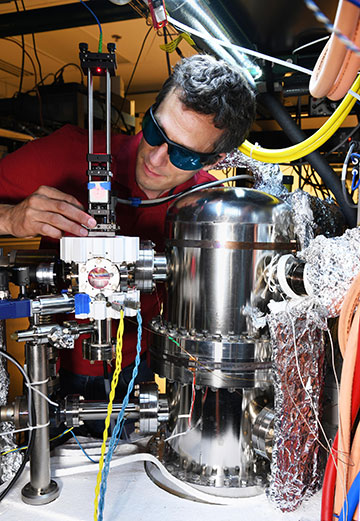
NIST vacuum heroes Dan Barker, Steve Eckel, Jim Fedchak, Julia Scherschligt and their colleagues have validated a method using laser-cooled atoms and magnetic traps to measure ultralow pressures. [Image: NIST]
What do semiconductor chip manufacturing, huge gravitational-wave observatories such as LIGO, and some varieties of quantum computers have in common? One thing is that the work of all three relies on the tricky feat of achieving, maintaining and measuring high to ultrahigh vacuum. A team of US scientists now says it has validated a vacuum metrology approach that could make the task substantially easier.
For the past seven years, researchers based at the US National Institute of Standards and Technology (NIST) have been developing next-gen, quantum-based vacuum sensors. These sensors, which go by the acronym CAVS (for cold-atom vacuum standard), rely on clouds of laser-cooled, magnetically trapped atoms and a bit of fluorescence magic to reliably measure vacuum down to the area of 10–8 Pa—less than a trillionth of sea-level atmospheric pressure.
In newly published work, the team has now reported the significant step of validating its quantum CAVSs against the classical gold standard for vacuum metrology, known as dynamic expansion (AVS Quant. Sci., doi: 10.1116/5.0147686). In the wake of that validation, the researchers believe that the CAVS approach—which they say is substantially easier to set up and use than dynamic-expansion systems—could enable simpler, more straightforward calibration of conventional vacuum-measurement systems. And a portable version, dubbed p-CAVS, might even replace some types of vacuum gauges in the field.
From a minus into a plus
The cold-atom approach to vacuum metrology works by turning a long-standing headache of the trapped-atom business on its head.
In a magnetic atom trap, neutral atoms possessing a magnetic moment, such as those of the alkali metals lithium and rubidium, are first cooled to sub-millikelvin levels, commonly by radiation pressure from a laser. Then, the cold-atom cloud is subjected to a high magnetic-field gradient, which traps the slow, cooled neutral atoms in local energy minima within the magnetic field.
The cold-atom approach to vacuum metrology works by turning a long-standing headache of the trapped-atom business on its head.
Even though a laboratory magnetic trap itself must operate in ultrahigh vacuum, no vacuum is perfect; there are always a few background gas atoms or molecules bouncing around within the vacuum chamber. These gas molecules will eventually collide with the magnetically trapped atoms and elbow them out of the trap. That means that the cold atoms can be held in place in a shallow magnetic trap for only a limited time, a constraint that needs to be taken into account in experiments.
Over the past decade or so, however, researchers have increasingly recognized that this inherent limitation in cold-atom trapping could be turned to advantage in another application—measuring extremely sparse vacuums. Specifically, if the rate at which atoms in the trap are bounced out by background gas atoms or molecules can be measured, it should be possible to determine the density of gas molecules, n, in the chamber. At that point, a simple application of the ideal gas law, p = nkT (where p is pressure, T is temperature and k is the Boltzmann constant) calculates the pressure in the vacuum chamber.
The CAVS approach
The NIST team has put this idea to work in two flavors of CAVS sensors. One, a laboratory-scale setup (l-CAVS), uses rubidium atoms as the sensor; the other, a portable CAVS (p-CAVS), uses lithium atoms.

A NIST video illustrates the basic processes at work in the CAVS system. [Image: NIST] [Watch video]
The CAVS device is first attached to the vacuum chamber to be measured, and remains in pressure equilibrium with the chamber as air is evacuated from it. When the chamber has reached full vacuum, a few hundred thousand Rb or Li atoms are laser cooled and captured in a magneto-optical trap (MOT). During the cooling and trapping process, the alkali-metal atom gas fluoresces, and the fluorescence signal is captured with a CMOS camera.
The MOT-captured atom cloud is then transferred to a quadrupole magnetic trap in the CAVS, and allowed to sit in the trap for a specific period. During that time, a share of the trapped atoms is kicked out of the trap by collisions with background gas molecules in the vacuum. The cloud of sensor atoms is then transferred back into the MOT, again giving off a fluorescence signal that is captured by the CMOS camera.
The difference between the fluorescence intensity in the second measurement and the first relates (with some assumptions) to the number of Rb or Li atoms pushed out through collisions with background gas atoms during the time the metal atoms were in the magnetic trap—and, thus, to the loss rate of atoms from the trap. The rate of trapped-atom loss, in turn, allows a direct calculation of the vacuum pressure attributable to the background gas, without reference to any other standard.
Validating CAVS

To validate the CAVS system, they attached it to a state-of-the-art classical dynamic-expansion system (gray), which sets a known vacuum level by precisely controlling the inflow and outflow of a known quantity of gases through the system. [Image: NIST]
In its recently published work, the NIST team validated the CAVS approach to vacuum measurement by first constructing a state-of-the-art dynamic-expansion system—the classical gold standard for calibrating vacuum gauges. The dynamic-expansion setup essentially uses the injection and removal of gases at a tightly controlled flow rate to set a known density of background atoms or molecules in the vacuum chamber. The complicated build by the NIST scientists included machining at the sub-micrometer level to enable sufficiently precise gas flow control through the system.
The team then attached both flavors of its CAVS to the dynamic-expansion system, and used each CAVS to measure the loss-rate coefficients for six species of inert process gases (He, Ne, N2, Ar, Kr and Xe) important in semiconductor manufacture. The team found that the coefficients agreed tightly with theoretical values for the background gas densities set by the dynamic-expansion system.
Put another way, the team writes, the result shows that “quantum-based measurement of vacuum pressure with cold atoms is consistent with that set by a combined flowmeter-dynamic expansion standard … Agreement between the dynamic expansion standard and the CAVS validates [the cold-atom sensors’] operation as quantum-based standards for vacuum pressure.”
Toward simpler measurement of ultrahigh vacuum

Team member Steven Eckel behind a p-CAVS unit (silver-colored cube at left) attached to a vacuum chamber (cylinder at right). [Image: C. Suplee / NIST]
The team sees a number of significant advantages in its quantum-based CAVS over classical approaches to vacuum metrology. One is that the CAVS pressure measurement is primary, with reference only to standards such as the SI second and the kelvin temperature unit. Thus, in principle, it could be used replace classical dynamic-expansion systems for calibrating other pressure gauges.
That could mean a significant win in simplicity, according to team member Julia Scherschligt. “The heavy lifting needed to stand up one of these classical standard devices is monumental,” she said in a press release accompanying the paper. “CAVS provides high accuracy in a much simpler form.”
Further, the team believes that the p-CAVS could be used not only for calibration of other gauges, but as a direct replacement for certain kinds of super-sensitive pressure metrology systems used in applications such as semiconductor manufacturing. To move these plans forward, the team will need to extend its validation work to measurements of more reactive background gases such as O2, CO2, CO and H2. The team is already working on upgrades to its test platform to enable those measurements.
